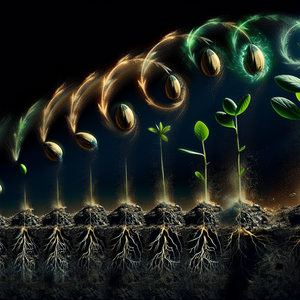Cultivating the Future: How Agricultural Robotics Engineers are Transforming Farming

Agricultural robotics has swiftly transitioned from a futuristic concept to a concrete reality, with engineers at the helm of this technological revolution. These professionals are creating robots capable of executing a wide array of tasks, from planting seeds and harvesting crops to monitoring livestock and analyzing soil health. These robots, equipped with advanced sensors and algorithms, are designed for precision and efficiency, often surpassing human capabilities in terms of speed and accuracy. For example, robotic harvesters can operate tirelessly, picking fruits and vegetables at their peak ripeness, thereby maximizing yield and minimizing food waste. The integration of drones equipped with sensors allows for comprehensive field surveys, providing farmers with critical data on soil health, crop conditions, and pest threats. This data-driven approach empowers farmers to make informed decisions, optimizing resource use and boosting productivity.
Efficiency and Cost Reduction
With labor costs constituting a significant portion of agricultural expenses, the advent of agricultural robots offers a viable solution to this challenge. The global population is projected to nearly 10 billion by 2050, amplifying the need for efficient food production systems. By automating labor-intensive tasks, agricultural robots reduce the reliance on human labor, thereby cutting costs and addressing persistent labor shortages. Robotic weeders, for instance, employ sophisticated algorithms to differentiate between crops and weeds, removing the latter without harming the former. This not only diminishes the need for herbicides but also reduces the time and labor dedicated to manual weeding. Similarly, automated milking systems have revolutionized the dairy sector, enabling farmers to milk more cows with less labor while maintaining consistent quality and hygiene standards.
Promoting Sustainable Practices
Sustainability has emerged as a central concern in modern agriculture, and robotics has a pivotal role in fostering environmentally friendly practices. Precision agriculture, facilitated by robotics, allows for the targeted application of water, fertilizers, and pesticides, reducing waste and minimizing the environmental footprint of farming activities. By optimizing resource use, farmers can lower operational costs and lessen their impact on ecosystems. Moreover, agricultural robots can be designed to operate on renewable energy sources, such as solar power, further enhancing sustainability. This shift towards eco-friendly farming practices is crucial in combating climate change and safeguarding food security for future generations.
Supporting Examples and Evidence
Real-world examples underscore the transformative potential of agricultural robotics. Blue River Technology, for instance, has developed 'see and spray' machines that utilize computer vision to identify and treat individual plants, significantly reducing chemical use. Similarly, Iron Ox, a robotics startup, runs autonomous greenhouses that optimize space and resource efficiency. Academic institutions are also making strides in this field. Researchers at the University of California have created robotic systems capable of autonomously navigating vineyards, collecting data, and performing maintenance tasks. These innovations highlight the practical applications of robotics in agriculture and the tangible benefits they offer.
Agricultural robotics engineers are at the forefront of a revolution that is reshaping the farming industry. By developing technologies that enhance efficiency, reduce costs, and promote sustainable practices, these engineers are paving the way for a future where global food demand can be met responsibly and efficiently. As these advancements continue to evolve, they will increasingly play a crucial role in ensuring food security. The work of agricultural robotics engineers is not only transforming farming practices; it is cultivating the future of agriculture, ensuring that we can sustainably feed the world.
Precision Agriculture Specialist
John Deere, Trimble Inc., Monsanto
Responsibilities
Implement data-driven solutions to optimize crop yields and resource use.
Collaborate with farmers to integrate GPS and GIS technologies for field mapping and monitoring.
Skills Required
Proficiency in using agricultural software and analytical tools.
Strong understanding of crop management and soil science.
Robotics Software Developer (Agriculture)
Blue River Technology, Iron Ox, AgJunction
Responsibilities
Develop and maintain software for agricultural robots, focusing on machine learning algorithms for crop identification and navigation.
Skills Required
Strong skills in programming languages like Python and C++.
Experience with ROS (Robot Operating System) and computer vision.
Agricultural Data Scientist
Climate Corporation, Granular, Bayer Crop Science
Responsibilities
Analyze large datasets from farm equipment and sensors to provide actionable insights for crop management and sustainability practices.
Skills Required
Expertise in statistical analysis, data modeling, and machine learning.
Experience with big data platforms such as Hadoop and Spark.
Field Robotics Engineer
Harvest CROO Robotics, Robotics Plus, Rowbot
Responsibilities
Design and implement robotic systems that can perform tasks such as planting, weeding, and harvesting in agricultural settings.
Skills Required
Proficiency in mechanical design, robotics kinematics, and sensor integration.
Hands-on experience with prototyping and field testing.
Agricultural Drone Operator
PrecisionHawk, DroneDeploy, AgEagle Aerial Systems
Responsibilities
Operate and maintain drones for surveying agricultural land, assessing crop health, and managing pest control operations.
Skills Required
Certification in drone operation and knowledge of UAV technology.
Familiarity with remote sensing and aerial imaging techniques.


